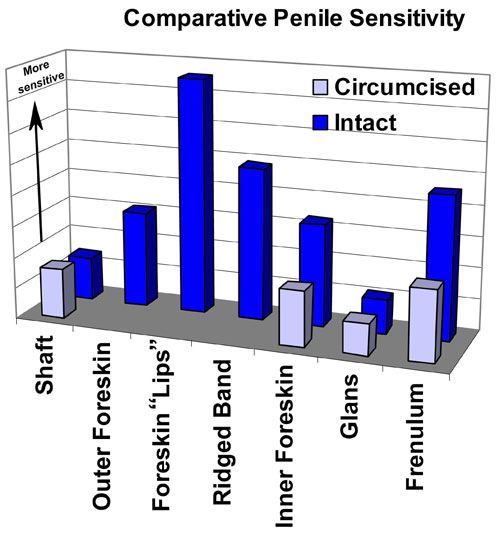 |
|
 |
Compute your Foreskin IQ
InstructionsNote your correct answers on the questionnaire (you can get as many as 3 points for #10), add them up, and multiply by 10 to get your Foreskin IQ. Answers (short form): The last choice is correct for all but #10, which is: b, c, a. Answers (with documentation):
1. d is correct. 15 square inches (95 cm2) is the average size of the adult human's foreskin.1 2. e is correct. a. The glans, with its associated sulcus (groove) and scar of the frenulum, are the most sensitive locations of the circumcised penis, but relatively insensitive compared to the foreskin.2
b. Corpus dictum is a bad pun submitted by a colleague.
c. The C-spot refers to the female clitoris.
d. Until recently, the frenulum and associated ridged band were believed to be the most sensitive portions of the foreskin but were recently proved not to be so.2
e. A recent study (the first of its kind—see chart below) revealed the foreskin “lips” or distal prepuce to be the most sensitive components.2
3. e is correct. All of these functions are provided by the foreskin and adversely affected by its loss.
4. e is correct. The foreskin of most infants is non-retractable at birth, which is normal; 6.5 percent of boys have a retractable foreskin by age 3-4 years.3 The average age of first, natural foreskin retraction is 10.4 years4 and most males will have a retractable foreskin by adulthood, but even then, 1-2 percent will never have a retractable foreskin and this is usually not problematic.5
5. e is correct. Previous unscientific claims eventually were exposed as false.6
6. f is correct. a. Cervical cancer, once thought to be lower in the partners of circumcised men, was later proven to be false.7 b. Studies have shown that the presence of a normal intact foreskin is not a risk factor for penile cancer.8 c. While there may be some partial medical benefits for certain boys in reduced bladder infection rates during their first year after birth, the findings are inconclusive because none of the studies controlled for forced retraction of the foreskin, which undermines its naturally protective function, and may well be the source of slightly increased infection rates—though no higher than in infant girls. d. Three poorly-interpreted African trials have led to an unfounded rush to recommend circumcision21—when in fact other studies show that circumcision in Africa is often the cause of HIV transmission.9 Circumcision has not been shown to be either cost-effective10 or worth the loss of later sexual functioning,2 and if forced upon a male, is a human rights violation.
7. c is correct.
In a study on condom sizes, it was discovered that intact penises are on the whole, about 1/3-inch longer.11
8. e is correct. a. No medical organization in the world recommends routine circumcision. b. Circumcision is extremely painful and anesthesia is only partially effective—newborns are proven to be more sensitive to pain than adults.12,13 c. While there may be some partial medical benefits, none have been shown to be cost-effective14 or worth the loss of later sexual functioning.2
9. c is correct. The fine-touch sensitivity of a circumcised penis is approximately 1/4th that of an intact penis.2
10. b, c, and a are the correct sequence. The US infant circumcision rate is the highest in the English-speaking (or European) world at about 57%.15 Canada's rate is about 9%16 and Britain's rate has been under 1% for decades.17
11. d is correct. In a study of over 1500 adolescent boys, about 90% of those who believed they knew their circumcision status were correct, but an additional 23% of circumcised, and 31% of intact boys, did not know their status, making a total of over 30% who were incorrect.18
12. e is correct. a. While mandated in Genesis 17, Jewish circumcision underwent radical changes during Roman times, when greater amounts of foreskin were removed—virtually unrecognizable from the original “nick” or drawing of blood.19 b. Jewish identity is determined by the mother's heritage, not circumcision status. Circumcision is not practiced by all Jews and is being questioned by some progressive followers of Judaism.20
c. Hospital circumcision does not meet the ritual criteria of a bris.19
- Taylor JR, Lockwood AP, Taylor AJ. The prepuce: specialized mucosa of the penis and its loss to circumcision. Br J Urol. 1996;77:291-5
- Sorrells ML, Snyder ML, Reiss MD, Eden C, Milos MF, Wilcox N, Van Howe RS. Fine-touch pressure thresholds in the adult penis. BJU Int. 2007;99:864-9. Chart below is based on this study.
- Kayaba H, Tamura H, Kitajima S, Fujiwara Y, Kato T, Kato T. Analysis of shape and retractability of the prepuce in 603 Japanese boys. J Urol. 1996;156(5):1813-5.
- Thorvaldsen MA, Meyhoff H. Patologisk eller fysiologisk fimose? Ugeskr Læger. 2005;167(17):1858-62.
- Øster J. Further fate of the foreskin: incidence of preputial adhesions, phimosis, and smegma among Danish schoolboys. Arch Dis Child. 1968;43:200-3
- Hodges F. A short history of the institutionalization of involuntary sexual mutilation in the United States. In: Denniston GC, Milos MF, editors. Sexual Mutilations: A Human Tragedy. New York: Plenum Press; 1997. p.17-40.
- Wynder EL, Mantel N, Licklider SD. Statistical considerations on circumcision aand cervical cancer. Am J Obstet Gynecol. 1960;79(5):1026.
- Dillner J, von Krogh G, Horenblas S, Meijer CJ. Etiology of squamous cell carcinoma of the penis. Scand J Urol Nephrol. 2000;Suppl.(205):189-93.
- Brewer DD, et al. Male and female circumcision associated with prevalent HIV infection in virgins and adolescents in Kenya, Lesotho, and Tanzania. Ann Epid. 2007;17:217–26
- Van Howe RS. A cost-utility analysis of neonatal circumcision. Med Decis Making. 2004;24:584-601.
- Richters J, Smith AMA, de Visser RO, et al. Circumcision in Australia: prevalence and effects on sexual health. Int J STD AIDS. 2006;17:547–54.
- Taddio A, Katz J, Ilersich AL, Koren G. Effect of neonatal circumcision on pain response during subsequent routine vaccination. Lancet. 1997;349(9052):599-603.
- Anand KJS, Hickey PR. Pain and its effects in the human neonate and fetus. New Engl J Med. 1987;317(21):1321-9
- Van Howe RS. A cost-utility analysis of neonatal circumcision. Med Decis Making. 2004;24:584-601.
- US National Hospital Discharge Survey for 2005. Available at: ftp://ftp.cdc.gov/pub/Health_Statistics/NCHS/Datasets/NHDS/nhds05.
- Canadian Institute for Health Information, 2005. http://secure.cihi.ca
- Waldeck SE. Using male circumcision to understand social norms as multipliers. UC Law Rev. 2003;72(3):455-526.
- Risser JM, Risser WL, Eissa MA, Cromwell PF, Barratt MS, Bortot A. Self-assessment of circumcision status by adolescents. Am J Epidemiol. 2004;159:1095–7
- Glick, LR. Marked in Your Flesh: Circumcision from Ancient Judea to Modern America. Oxford University Press, 2005. p. 44-5.
- Jewish Circumcision Resource Center: www.jewishcircumcision.org
- Green LW, McAllister RG, Peterson KW, Travis JW: Male circumcision is not the ‘vaccine’ we have been waiting for! Future HIV Ther. 2(3), 193–199 (2008).
 Data plotted by International Coalition for Genital Integrity (ICGI.org) from: Sorrells ML, Snyder ML, Reiss MD, Eden C, Milos MF, Wilcox N, Van Howe RS. Fine-touch pressure thresholds in the adult penis. BJU Int. 2007;99:864-9.
|
 |
 |
|
 |
|
 |
|
 |
|
 |
|
 |
|
 |
|
 |
|
 |
 |
 |
 |
| |
 |
|
|
 |
Personal Wellness
Wellness is about you. It is about learning to love your whole self. It is about assuming charge of your life, living in process, and channeling life more... |
|
 |
Helping Professionals
This area consists of text from Wellness for Helping Professionals, by John W. Travis, MD, and Meryn Callander. more... |
|
 |
|
 |


